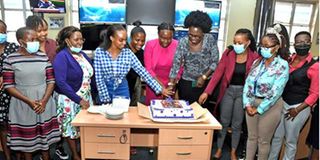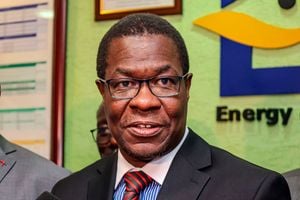Have more women lead media

NMG Group Managing Editor Pamela Sittoni (in pink) and Gender Editor Dorcas Muga-Odumbe (fourth right) lead other NMG staff in cutting a cake in celebration of International Women’s Day at Nation Centre, Nairobi, on March 8, 2022.
What you need to know:
- The most alarming finding was the dearth of women in headline stories.
- Women should be encouraged to upskill and advance their skills and knowledge in media.
Women are underrepresented in business and editorial positions within media houses throughout East Africa.
Despite significant improvements, we are not there yet, posing challenges to gender equality and representation in society.
A recent research report, “The State of Women in Media”, brought to light troubling disparities.
The study, by the Aga Khan University Graduate School of Media and Communications in collaboration with the Aga Khan Foundation and Global Affairs Canada, found that while women constitute a significant portion of the media workforce, they are disproportionately underrepresented in key areas, particularly in editorial leadership and in the creation and dissemination of news stories.
The report highlighted distinct variations in the framing and coverage of women in Kenya, Uganda and Tanzania.
While each of the countries was seen to have unique challenges and opportunities, women evidently face systemic barriers to equitable representation in the media.
The most alarming finding was the dearth of women in headline stories, which are considered significant markers of societal importance.
That not only perpetuates gender stereotypes but also reinforces the marginalisation of women’s voices and experiences in public discourse.
Gender diversity
Confronting these disparities and working together to amplify women’s voices, challenge existing narratives and advocating gender-inclusive media practices to effect meaningful change is, therefore, vital. Here are some measures we can take:
Promoting gender diversity in the newsrooms and media leadership. The presence of women in decision-making significantly influences the framing of gender-related issues. Gender-diverse assignment of responsibilities ensures balanced storytelling.
The report noted that Tanzania has the highest representation of women in the media workforce in the region at 46 per cent, followed by Uganda (44 per cent), then Kenya (39.5 per cent).
Women in editorial leadership positions across the three countries varied, with Tanzania leading at 40 per cent of the analysed media organisations with Uganda at 33 per cent and Kenya 11 per cent. While the study was conducted in East Africa, others in other markets show similar results.
A study by the Reuters Institute and the University of Oxford in 2023 which analysed 12 markets showed only 22 per cent of the 180 top editors across the 240 brands covered are women, even though, on average, 40 per cent of journalists in the 12 markets are women.
This was echoed by a 2021 Global Citizen article, that women reporters were only responsible for 37 per cent of stories.
Increasing skills and knowledge. Women should be encouraged to upskill and advance their skills and knowledge in media. This can be done through fellowships and mentorship programmes which promote growth.
Gender-sensitive reporting
Higher education institutions should offer graduate education and professional development courses to qualified women in the media to bridge the gap.
This is one of the challenges we have taken up at the Graduate School of Media and Communications at AKU, where 58 women from various media organisations have graduated from our graduate programmes since 2018, making it 41 per cent of the total so far.
This has been made possible through needs-senstitive financial assistance from the institution and support from development partners such as KFW, the German Development Bank.
Promoting gender-sensitive reporting and research. Journalists should be trained on gender-sensitive framing and storytelling to ensure accurate portrayals of women.
Besides, media houses should have dedicated gender desks to enhance the coverage of women in different sectors, presenting a more comprehensive narrative of their stories, continually monitoring gender representation areas in newsrooms and openly advocate improvement.
Media houses and academic institutions should promote media research to inform decision-making around business models, audience engagement and content strategies.
They should advocate gender-sensitive research to provide the data highlighting the critical issues in the sector so that interventions are well guided.
The role of the media in women’s empowerment is critical. Media outlets should increase the visibility of female writers and women’s stories in all their platforms all year round. Today’s International Women’s Day is a good starting point.
Prof Booker is Dean, the Aga Khan University Graduate School of Media and Communications





